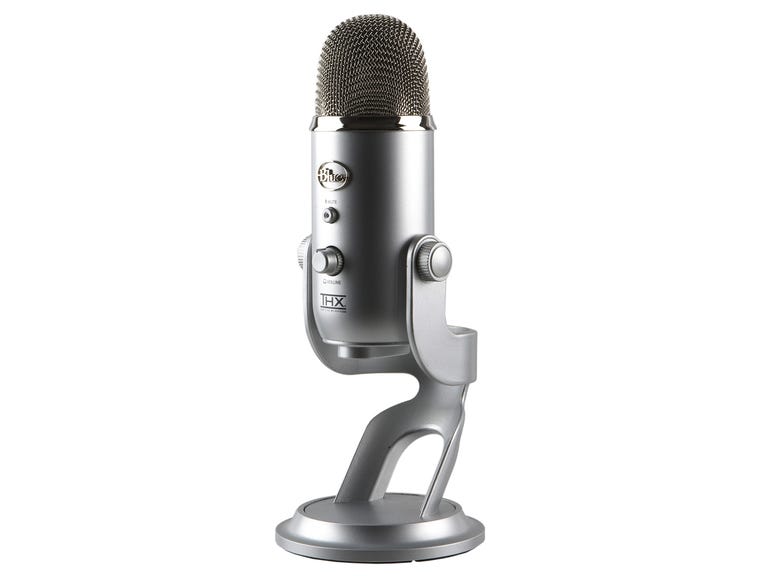 Why You Can Trust CNET
Why You Can Trust CNET Blue Microphones Yeti USB Mic review: Blue Microphones Yeti USB Mic
Blue Microphones Yeti USB Mic
The Good
The Bad
The Bottom Line
From the company that brought you the Snowball, and the Snowflake, comes the Yeti--a $149 USB microphone destined to ravage and plunder desktop-recording studios.
If you're wondering why Blue Microphones would name its microphone after a mythical abominable snowman, then you should see the Yeti in person. This thing is huge--like, disturbingly huge. It measures a foot tall, weighs 3.5 pounds, and makes most microphones look like Happy Meal toys.
But beyond its intimidating size, the Yeti moniker is just as fitting a way to describe its sound. Compared with similar microphones, such as the Samson G-Track or even Blue's own $99 Snowball, the Yeti's sound quality offers noticeably better depth and detail. It produces a big sound from a big microphone.
From a features perspective the Yeti offers zero-latency headphone monitoring, headphone volume control, and a handy little mute button that's perfect for those times when you need to clear your throat. On the back, you have a knob that allows you to directly control the mic's gain. Beneath the gain dial is the real crown jewel of this mic: a multipattern selector switch with four recording modes. Like the Snowball, you have an omnidirectional mode, for picking up sound from all directions, and a cardioid pattern, for focusing on sound directly in front of mic. Because the Yeti uses a unique, three-capsule design (instead of the two included on the Snowball or the single capsule used by most other microphones), the microphone offers two more recording patterns: a stereo mode, and a bidirectional mode that pulls sound from directly in front or behind the mic.

While not as flashy a feature as capsule count, the solid-metal man-shaped stand does a better job than the G-Track or Snowball at placing the microphone at mouth level. That said, if the cutesy-ness of the stand is overwhelming, a standard mic mount is also included on the bottom of the Yeti.
Unfortunately, the wobbly plastic knobs used for volume and gain control seem out of place on the otherwise brick-solid Yeti. During our few weeks of testing, the flimsy-feeling knobs never let us down, but their seemingly delicate design should probably be handled with care. If you're a chronic klutz, a two-year warranty against defects is included.
When it comes to performance, the Yeti has plenty to brag about. For starters, this is the first microphone or audio input device to receive the coveted THX certification. The certification involves a multitude of factors, including tests for frequency response and signal-to-noise ratio, and--perhaps more importantly--proof of performance consistency across multiple product batches. In other words, the Yeti had to sound good and have a reasonable chance of sounding good for every user.
The Yeti's three-capsule, multipattern microphone design is another first for the USB microphone world. The three 14mm mic capsules are arranged in a slightly offset, "="" rel="follow" target="_self">triangular layout, affording four different recording patterns, including stereo--which is a rare find for a relatively large capsule microphone like this. And although we're big fans of the mic capsules used on Blue's Mikey and Snowball products, Blue's product representative was quick to point out that the Yeti uses a new capsule design with a slightly different tuning that takes advantage of the three-capsule layout.
Of course, you'll need to hear the Yeti for yourself to really appreciate what the microphone has to offer. We've included a few audio samples to give you a sense of the superior depth and recording range of the Yeti compared against similarly priced USB microphones.
Jasmine podcast intro, Yeti (cardioid pattern, distance: 2 feet)
Listen now:
Jasmine podcast intro, Snowball (cardioid pattern, distance: 2 feet)
Listen now:
Jasmine and Donald podcast intro, Yeti (bidirectional, distance: 12 inches)
Listen now:
Donald voice test G-Track (cardioid, distance: 12 inches)
Listen now:
Donald voice test Snowball (cardioid, distance: 12 inches)
Listen now:
Donald voice test Yeti (cardioid, distance: 12 inches)
Listen now:


